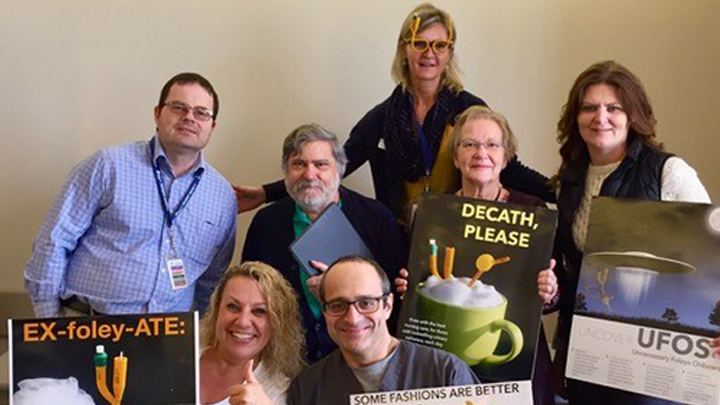
May 14, 2018

Medicine Hat physician Dr. Susan Witt, pictured here with her team, says approximately one third of catheters are inserted for potentially inappropriate reasons. With the new protocol in place, medical staff will be able to decrease the amount of unnecessary catheters, reduce the risk of infection and lessen the number of complications and poor outcomes.
Story by Alex St. Cyr
Patients in South Zone are receiving fewer urinary catheters and have a significantly reduced risk of infection, thanks to a physician-led quality improvement project at Medicine Hat Regional Hospital.
The Catheter Optimization Project aims to reduce unnecessary catheterization of inpatients, as well as resulting complications, by introducing a Foley catheter pathway and an awareness campaign for clinicians. Since the project was launched in June 2016, the facility has seen a 35 per cent reduction in absolute catheter numbers and a 38 per cent reduction in catheter prevalence.
“Ensuring patients receive catheters only when completely necessary can significantly improve the in-patient experience and outcomes,” says Dr. Susan Witt, Physician Lead, Quality Improvement at Medicine Hat Regional Hospital.
“With the time and space allowed to take this project from the ground up, we enjoyed having the creative freedom to address a clear need in hospital settings.”
The Foley catheter pathway developed by Dr. Witt and her team included specific criteria to determine when a catheter was necessary for patients and also provided the framework to standardize how medical staff deal with catheterized patients.
The project also focused on fun and creative ways to share their messages and collect data. This included edgy collateral materials such as posters captions like ‘decath, please,’ ‘ex-Foley-ate’ and ‘uncover UFOs (unnecessary Foleys onboard),’ along with education sessions with an interactive ‘Catheter Jeopardy’ for healthcare providers.
“We based much of our preliminary planning on the work done by the Choosing Wisely campaign’s Lose the Tube guidelines, but were then able to work with local experts, including our urologist, Dr. T. Alphin, whose expertise and support was invaluable,” Dr. Witt says.
One in five inpatients in Alberta receive a catheter during their hospital stay. However, Dr. Witt says approximately a third of catheters are inserted for potentially inappropriate reasons. While a necessary part of care in some circumstances, urinary catheters can be painful, and increase the risk of infection, complications and poorer outcomes.
“It is very exciting to realize positive changes for patients and make the care team’s work run more smoothly,” she says. “My physician and nursing colleagues are working at top speed with a great deal of complexity, so any changes we make have to be easily accomplished by providers, in addition to the overarching goal of making the care safer for patients.”
Dr. Witt says that a number of factors contributed to the success of the project, including being able to gather data using iRounds, a patient satisfaction survey tool, as well as daily multidisciplinary rounding which included the review of inpatients’ catheter status. But she says that it was the Quality Innovation Fund that allowed her team make the project a reality.
“We know how uncomfortable catheters can be for patients. While we’ve achieved a reduction in catheter use here in Medicine Hat and increased awareness about the potential harms of catheterization, our work still isn’t done,” says Kirby Peterson, Quality Consultant who also worked on the project.
“The team will continue to support providers and spread this work across the South Zone, especially at sites that lack a catheterization protocol.”